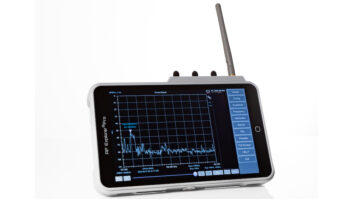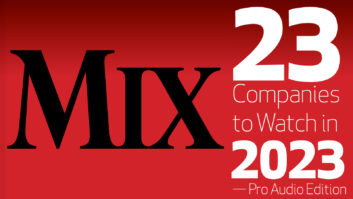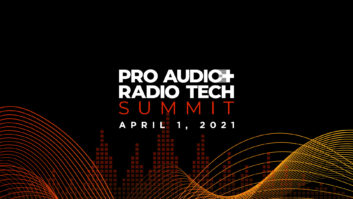The June, 2014 issue of Pro Sound News features an extensive discussion between numerous major players in the FCC R&O concerning RF and its implications for the pro audio industry. What follows is additional insights offered by those interviewed for the article.
The FCC’s Incentive Auction R&O may signal the end of relatively unfettered access by wireless mic operators to the 600 MHz band, but at least the commission’s rulemaking recognized their importance by bringing amendments to Part 74 eligibility to a vote on the same day. “What was momentous was that a long-awaited resolution to the expansion of wireless microphone eligibility classes was paired with the Incentive Auction Report and Order,” says Shure’s Mark Brunner.
“We were pleased that both items made it to the agenda on the same day. We have been, as manufacturers and other users have been, advocating for license expansion for quite some time. The original Part 74 rules were written in 1979 and never really revisited, despite obvious changes in the adoption of wireless pro audio.”
Audio-Technica’s Jackie Green agrees: “They took a lot of time to say a lot of stuff about wireless microphones. At least they’re taking us into consideration.”
After numerous meetings between the FCC and mic manufacturers, frequency coordinators and operators, the commission came to understand the extent to which these groups collaborate on a regular basis, says Green. “I think the group worked really well together. Hopefully, going forward, that’ll make it easier to advocate for the needs of the wireless community.”
She continues, “I don’t think they realized how much we all cooperate with each other, and how many channels we use on a constant basis across the country. That actually takes a large cooperative coordination effort on all of our parts. Everybody had already pitched in, and worked hard, and figured out ways to survive in the hostile spectrum environment. I think they were surprised by that.”
“I feel a certain sense of satisfaction that we’ve been able to have these various user groups be recognized,” says Brunner, “because when we went into the TV white space issues in the DTV transition, this level of usage simply wasn’t on the radar. And that was because, if you went to FCC databases and looked at how many license holders there were, and who they were, you might quickly conclude that that’s how few microphones were out there!”
Under the new rulemaking, Part 74 eligibility has been expanded to include professional sound companies and indoor and outdoor venues that routinely use 50 or more wireless microphones. The venue does not have to own the mics to qualify, but must routinely host large-scale productions requiring 50 or more RF mics.
The numerous users operating without licenses (and thus not showing up in the FCC databases), including those who do not meet the 50-mic threshold for expanded Part 74 license eligibility, may continue to operate under the terms of the existing waivers put in place by the 2010 Wireless Microphone Report and Order. Those waivers remain in effect until the FCC makes a determination on rules for unlicensed operations “at a later date,” according to the R&O.
Licensing more pro audio wireless operators is a good thing, says Lectrosonics’ Karl Winkler. “All pro class wireless users need to have priority above unlicensed use of the spectrum. That means that whatever white spaces are left, whether they be in the guard bands, the mid-band gap, between TV stations, below 600 MHz or wherever, pro wireless mic users will have priority; that’s very good news.”
But, he continues, “How good that news is in terms of practical application depends on the accuracy of the databases. We want to have a robust system so that wireless mics can count on it, so that you or I or one of our users could go in there, register, and within a fairly short amount of time—say, 15 minutes—have the database updated and have white space devices kicked off. That’s going to be critical for success in the UHF band—and, frankly, other bands, because, again, they will all be shared.”
By forcing wireless mic end-users out of the 600 MHz band less than five years years after mandating that they vacate the 700 MHz band, the FCC is effectively driving the microphone manufacturers to innovate. Of course, without knowing what spectrum the FCC might be able to set aside for wireless mics in the future, for licensed, exclusive use or otherwise, manufacturers have to take educated guesses about where to focus their R&D efforts.
“I think [the FCC] is going to make a genuine effort to accommodate what really is a huge industry,” Green believes. “They mentioned that they thought they would be looking this summer for letting us know what other bands we might get. So I’m thinking that 2014 is just going to be a really interesting year for us. There’s going to be a lot of work for us to do. We need to keep our noses to the grindstone, and keep advocating for wireless mic users.”
As Brunner has noted, manufacturers would prefer the new allocated spectrum to be as close as possible to the existing frequency ranges. “I think that, in general, the manufacturers would like to concentrate on things that are closer to UHF because of the similarity in the technologies that we already have, but also for the fact that those bands are allocated for our microphones in other major markets, like Japan and Germany. Some companies are already making products in a 1.2 GHz band and a 1.8 GHz band.” While those specific frequencies aren’t currently ideal in the U.S., the 1 to 2 GHz range certainly does hold promise, he says.
“But we haven’t ruled out other bands, too. The 3.5 GHz band is an open proceeding right now; they’re in the early stages of rulemaking there. There’s a lot of interest in it from several different camps, consumer-oriented products as well as pro. But we know that that band, because it’s already occupied by coastal radar, or has to be database-controlled, will inherently require a different type of technology,” continues Brunner.
There could also be room for expansion in the 900 MHz band, he adds. Ironically, VHF now holds a lot of potential: “It’s kind of funny, because we exited that band to populate UHF years ago, but now we’re seeing some new opportunities emerge there.” Radio Active Design, a new intercom company co-founded by RF guru James Stoffo, recently launched products in the UHF band, for example.
“The FCC got what they wanted,” says Green. “They wanted to force technology changes. And as a result of their pressure, we recently got a patent for a method to do high-density wireless so that you can pack very large channel counts of analog wireless into a band. I’m sure that my colleagues at the other companies are working in R&D with a comparable fervor. The FCC did create that environment and say, you’d better take stock of this, and you’d better do something different.”
For developers, there is a matrix of tradeoffs and challenges throughout the frequency bands, Green continues. For example, “If I go super high, I don’t need to use companding or compression, maybe. It just depends where you are on the band what your technical difficulties are to overcome.”
Audio-Technica already has its Ultra Wide Band (UWB) system in the 6 GHz range and above. “It’s currently a conference system but it’s possible to turn it into a pro-quality live sound or broadcast system, and have the correct channel count, frequency response and dynamic range, without added latency. If we can do that, my guess is that other people can figure out other solutions.”
Latency is a critical issue in some applications. According to the DTV Audio Group’s Roger Charlesworth, the loss of UHF spectrum will have the greatest impact on any artist with a hand mic and in-ear monitors trying to hear themselves in stereo and high-fidelity with low latency. “That’s where it’s still going to be very hard to replace FM transmitters and receivers operating in clean UHF spectrum,” he says.
As Winkler also points out, “If you’re looking at 915 MHz or 2.4 GHz you’re talking about unlicensed spectrum, and there’s no way to predict what’s going to be there. There’s no database protection, nothing; it’s not reliable spectrum.”
Lectrosonics, like some of the other manufacturers, offers products in those bands, he continues, but they have limitations. “The systems that are developed there work well, but the channel count’s very limited. Any other part of the spectrum, including six-gig, is limited channel count and limited range, despite some claims to the contrary.”
The FCC clearly did not realize how many wireless mics are regularly in use when the commission cleared the 700 MHz spectrum for use by DTV, according to Winkler, and now operators are being squeezed out of the 600 MHz band. “That was painful, to say the least, and will be even more so as this rolls out. We lost a fourth of what was available, we’re losing a third of what’s available now, and that leaves a pretty tiny, very highly-packed bit of spectrum in the UHF band.”
Even today there isn’t enough spectrum to accommodate the number of channels needed on regular events, never mind special productions such as Super Bowl or the Grammy Awards telecast. “That’s one of the messages that we took to [the FCC],” reports Winkler. “We brought charts and collections of information showing what some of these big events are using; even day-to-day stuff—reality TV, for example, or municipal theatre, rock touring, whatever it might be. It’s everything from a dozen to a hundred channels that’s being used today, routinely, by people that you would never even think of. So it will definitely have an impact there; it will have an economic impact.”
Meanwhile, says Winkler, “We’re in a holding pattern, in terms of what spectrum we’ll have access to. We’ve looked at 1.4 GHz, there’s some stuff at 1.8 GHz, there’s 3 GHz, 3.5 GHz. And of course, these pieces of spectrum, because of the propagation characteristics, would need differently designed equipment.”
Consequently, manufacturers need as much notification as possible of the FCC’s promised new wireless mic frequency allocation so that they can ramp up their R&D. “We need the rulemaking to happen quickly, because we’re going to lose the spectrum we’re in today, and if we don’t have somewhere to go in a reasonable amount of time there’s going to be a gap in the ability to provide content,” says Winkler.
The new 600 MHz band plan most likely faces legal challenges, which means that the current deadline of 36 months following the three-month filing period for TV stations to relinquish their frequency allocation and relocate following the channel repack could be moot. That might give wireless mic users some breathing space, but the future still looks challenging for manufacturers.
“Every piece of spectrum will be hotly contested,” predicts Winkler. “We know that 3.5 GHz is going to be hotly contested. We know 1.8 GHz is going to be hotly contested. Doesn’t matter where it is—the spectrum is valuable, and people don’t want to share. That’s going to be another ugly battle.”
Of course, everybody knew the DTV transition was eventually going to happen in the United States, even if the timing was a little uncertain for a while. “Back in ’97 was when this first started, and in 2000, we said, what are we going to do? How are we going to protect our end-users and our customers? It’s going to start becoming very complicated, and very restricted,” says Green.
“So that’s part of the reason we started looking at UWB technology. It’s part of the reason we developed our 2.4-gig product, which is a mass-market product. And we also developed three different products that work in the VHF range.” In some parts of the world, she observes, infrared wireless audio mics are popular.
“I don’t want to put a quality judgment on it and say better or worse, because everybody’s need is just as important to them as anybody else’s needs. But there are certain performance characteristics that change, depending on how you’re trying to use your microphone,” says Green.
“We need different tools for different markets. And in the long run, man, we’re going to have to pull all of those tools out of the toolbox!”






